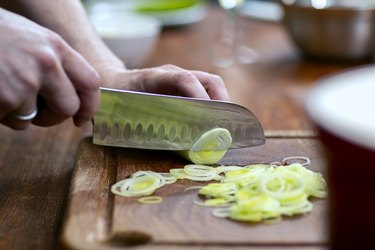
Your go-to kitchen knife needs to be able to do more than just slice through an onion. Ideally, it feels balanced while in use and more like an extension of your hand than an unwieldy tool. If you're serious about finding a lifelong knife companion, then many professional chefs would recommend selecting a high-carbon steel kitchen knife.
What Is High-Carbon Steel?
Video of the Day
The identifier "high-carbon steel" suggests that the presence of carbon is what makes these knives special. But really, any steel knife, including stainless steel, has some carbon present. The difference in a high-carbon steel knife is that it has at least 0.8 percent of carbon present. Ultra-high carbon knives have a carbon range of 1.25 to 2 percent.
Video of the Day
The higher levels of carbon create a unique knife experience that comes with some serious cutting advantages. However, the carbon properties will also require more care and maintenance to keep the knife serviceable.
High-Carbon Steel Knife Pros
The higher levels of carbon create a blade that is harder when compared with stainless steel. Obviously, this is a major selling point when it comes to knives. The blade is not only harder, but it is also more receptive to sharpening, so you can work with a razor-sharp edge every time you chop.
Serious chefs looking for a kitchen knife companion also appreciate how a high-carbon steel kitchen knife changes over time as it has more cutting experiences. With regular use, food acids and moisture will build a patina on the knife's surface. This protective coating creates a more raw material look and also adds an iridescent gradient of gold, blue, purple, and gray. The unique color design tells the story and experience of every high-carbon steel kitchen knife.
High-Carbon Steel Knife Cons
Carbon steel knives contain just what's in the name, carbon and steel, and have very little chromium. Stainless steel has an added element called chromium, which assists with rust and corrosion protection (get it — stainless). This leaves carbon steel at a disadvantage when it comes to showing wear and tear. Carbon steel is also more brittle, meaning the knife will show more dings and damage when dropped compared with a stainless steel knife.
High-Carbon Knife Care
So carbon knives may be more susceptible to rust and damage when left untreated. But if you practice diligent maintenance and care, then you can keep your exceptionally sharp blade looking beautiful too. Immediately after using a carbon steel knife, wash it and most important, dry it. This will prevent oxidation and acid residue from food and water from settling into the metal.
Before putting away the knife, rub a few drops of food-grade mineral oil into the blade using a cloth and being careful not to cut yourself. The oil will prevent oxidation, which will prevent rust, and it will help the blade develop its protective patina layer.